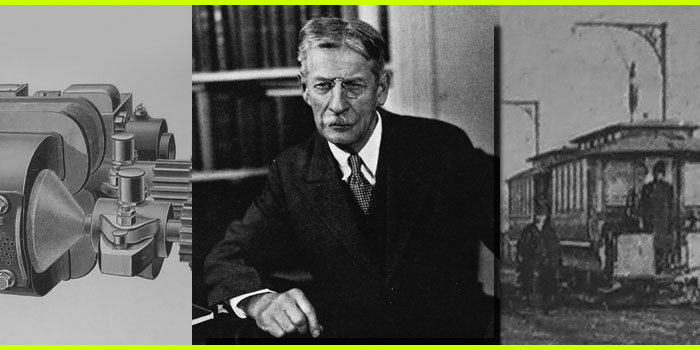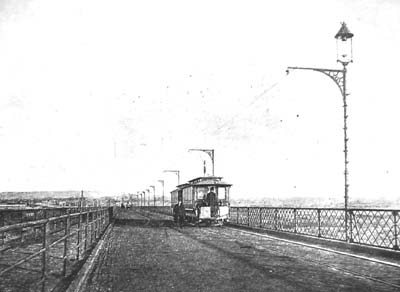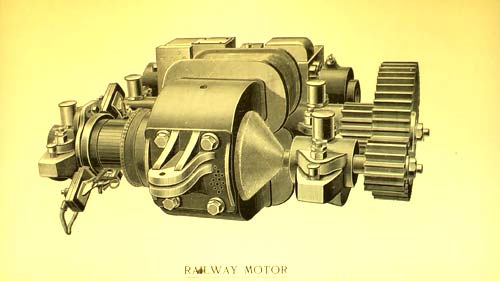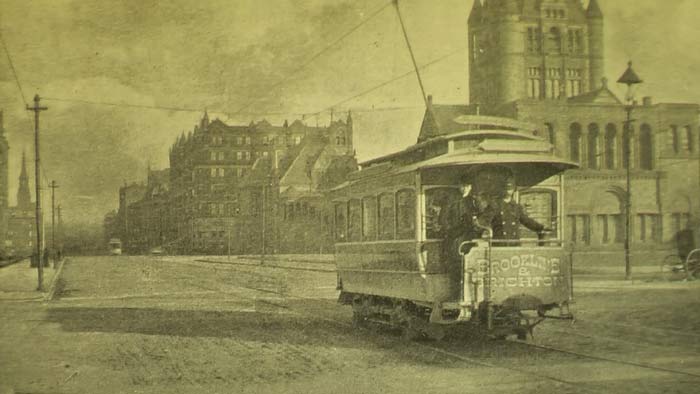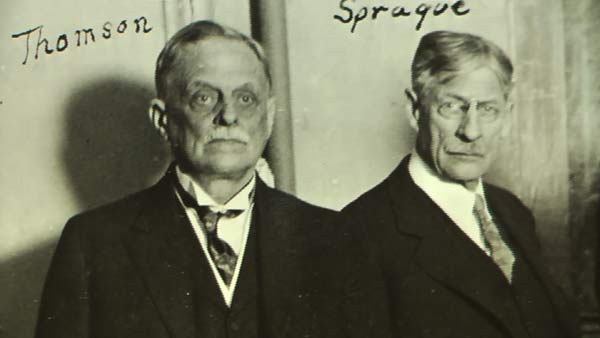
|
Engineering Hall of Fame |
Frank Julian Sprague
The accomplishments and life of F.J. Sprague. 1857-1934
Hailed during his lifetime as the "Father of Electric Traction" by leaders in the fields of science, engineering and industry, Frank Julian Sprague's achievements in horizontal transportation were paralleled by equally remarkable achievements in vertical transportation. During a six-decade career, Sprague distinguished himself as an inventor for his accomplishments in the development of the electric railway, early electric elevators and the commercial electric motor.
Biography Frank Julian Sprague (1857-1934)
Sprague was born in Milford, Connecticut in 1857. He attended Drury High School and excelled in mathematics. Sprague won the appointment to the U.S. Naval Academy, and with US $400 in borrowed cash, set out for Annapolis, Maryland, in 1874.
Graduating seventh in a class of 36 in 1878, Sprague was assigned to the USS Richmond, flagship of the Asiatic Fleet, where he filled a notebook with detailed drawings and descriptions of devices that evidenced his urge for invention. Among these were a duplex telephone, quadruplex and octoplex telegraph systems, a motor and a means of transmitting pictures by wire. Later, Sprague was ordered to the USS Minnesota. While his ship was in Newport, Rhode Island, in 1881, Sprague invented the inverted type of dynamo. Also in 1881, Spraque transferred to the USS Lancaster, flagship of the European Squadron, on which he installed the first crude electrical call-bell system in the Navy.
Sprague took leave to attend the Paris Electrical Exhibition and the Crystal Palace Exhibition in Sydenham, England, where he served as the only American member and as secretary of the jury of awards for gas engines, dynamos and lamps.
Meanwhile, Sprague's ideas about motors and lamps had so impressed E.H. Johnson, a business associate of Thomas A. Edison, that he convinced Sprague to resign from the Navy in 1883 to become a technical assistant to Edison. While on Edison's staff, Sprague assisted in the installation and operation of Edison's pioneer three-wire electric light systems. Sprague also revised and corrected the Edison system of mains and feeders for central station distribution and developed a formula for determining the ratio of wire size to current amperage.
However, Edison's primary interest was in light, while Sprague was interested in power. He resigned his position after about a year and started the Sprague Electric Railway & Motor Company in 1884. During the next two years, Sprague produced a number of inventions of major significance.
The first was a constant-speed, nonsparking motor with fixed brushes. The first motor to maintain constant revolutions per minute under different loads. Sprague's invention caused such a stir at its first showing at the Franklin Institute's Electrical Exhibition in Philadelphia that the company sold 250 motors in two years.
In 1885, the Edison Electric Light Company officially endorsed Sprague's motor in a circular sent to its local companies. "A practical motor has been a want seriously felt in our system," it read. "The Sprague motor is believed to meet . . . all the exigencies of the case, and the Edison Electric Light Company feels it can safely recommend it to all its licensees as the only practical and economic motor existing today."
Next, Sprague designed a method to regenerate -- or return -- power to the main supply systems of electric-motor-driven equipment, such as elevators and trains for economy and braking. This was later used extensively on mountain grades in electrical train operation and for interchange of energy in elevator groups. Additionally, Sprague developed a distorted system of compound field magnet winding that maintained a fixed nonsparking position of commutator brushes and a three-point, wheelbarrow suspension of axle-mounted geared motors for electric railways, which was soon used universally for trolley-car equipment.
A Thomson-Houston railway motor from the 1880s
Sprague incorporated many of these inventions in the equipment his company installed for the Richmond (VA) Union Passenger Railway in 1887-1888, the first large-scale electric trolley line in the world. Within two years of its opening, 110 electric railroads using Sprague's equipment were built or under contract, including systems in Italy and Germany.
In 1890, Edison General Electric Company, which manufactured much of Sprague's equipment, purchased and absorbed the Sprague Electric Railway & Motor Company, and Sprague turned his attention to the field of vertical transportation.
Elihu Thomson and Frank Sprague in their later years working for General Electric
Back to the Engineering Hall of Fame
Photos:
Edison Tech Center
Schenectady Museum
Photo/Video use:
Commercial entities must pay for use of photos/graphics/videos in their web pages/videos/publications
No one commercial or public is allow to alter Edison Tech Center photos/graphics/videos.
Educational Use: Students and teachers may use photos and videos for school. Graphics and photos must retain the Edison Tech Center watermark or captions and remain unmanipulated except for sizing.Permissions - Videos: We do not email, FTP, or send videos/graphics to anyone except in DVD form. Payment is needed for this service. See our donate page for pricing, and our catalogue for a listing of videos on DVD.
Professional video production companies may get videos in data form with signed license agreements and payment at commercial rates.
Copyright 2013 Edison Tech Center
